
Aslauga is a genus of butterflies in the family Lycaenidae. They are associated with other insects and found only in the Afrotropical realm. They are small usually grey-blue or grey-purple butterflies with a distinctive, but widely varied wing shape, especially pronounced in A. pandora. They are forest butterflies of the Congolian forests and Lower Guinean forests.
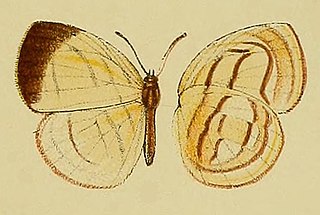
Batelusia is a genus of butterflies in the family Lycaenidae. The genus contains only one species Batelusia zebra from Cameroon and the Republic of the Congo and endemic to the Afrotropical realm. Both the genus and species were first described by Hamilton Herbert Druce in 1910.

Neaveia is a monotypic butterfly genus in the family Lycaenidae which is endemic to the Afrotropical realm. Its only species, Neaveia lamborni, the pierine blue, is found in Ivory Coast, Ghana, Nigeria, Cameroon, the Republic of the Congo, the Democratic Republic of the Congo, Uganda, Kenya and Tanzania. Both the genus and species were first described by Hamilton Herbert Druce in 1910. The habitat consists of forests and open areas.
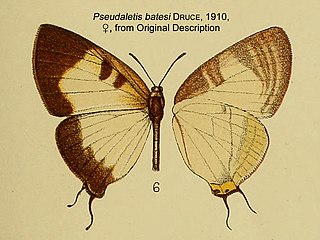
Pseudaletis batesi, the black fantasy, is a butterfly in the family Lycaenidae. The species was first described by Hamilton Herbert Druce in 1910. It is found in Cameroon, the Republic of the Congo, the Central African Republic and the Democratic Republic of the Congo. The habitat consists of forests.

Iolaus neavei, or Neave's sapphire, is a butterfly in the family Lycaenidae. The species was first described by Hamilton Herbert Druce in 1910. It is found in Nigeria, Cameroon, the Republic of the Congo, the Democratic Republic of the Congo, Uganda and Tanzania. The habitat consists of forests.
Aslauga aura is a butterfly in the family Lycaenidae first described by Hamilton Herbert Druce in 1913. It is found in Cameroon, Gabon and the Democratic Republic of the Congo.
Aslauga confusa is a butterfly in the family Lycaenidae. It is found in Cameroon, the Republic of the Congo and Gabon.
Aslauga imitans, the imitating aslauga, is a butterfly in the family Lycaenidae. It is found in Ghana, western Cameroon and the Democratic Republic of the Congo.

Aslauga kallimoides, the imitating aslauga, is a butterfly in the family Lycaenidae. It is found in southern Cameroon, the Republic of the Congo and the Democratic Republic of the Congo (Equateur).
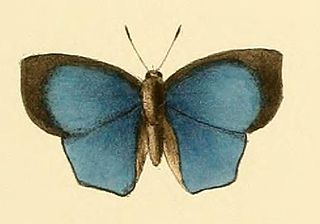
Aslauga vininga, the central aslauga, is a butterfly in the family Lycaenidae. It is found in Nigeria, Cameroon, Equatorial Guinea (Bioko), Gabon, the Republic of the Congo, the Democratic Republic of the Congo, Tanzania and Zambia.
Aslauga lamborni, the Lamborn's aslauga, is a butterfly in the family Lycaenidae. It is found in Sierra Leone, Ivory Coast, Ghana, southern Nigeria, Cameroon, the Republic of the Congo, the Democratic Republic of the Congo and western Uganda. The habitat consists of primary forests.
Aslauga marshalli, the dusky purple, is a butterfly in the family Lycaenidae. It is found in Cameroon, Angola, the Democratic Republic of the Congo, Burundi, Uganda, Kenya, Tanzania, Malawi, Zambia, Mozambique, Zimbabwe and possibly Nigeria. The habitat consists of savanna, Brachystegia-Julbernardia woodland, marshes and shallow lakes.
Aslauga prouvosti, the Prouvost's aslauga, is a butterfly in the family Lycaenidae. It is found in Cameroon, the Democratic Republic of the Congo (Shaba) and western and north-western Tanzania.

Aslauga purpurascens is a butterfly in the family Lycaenidae. It is found in Cameroon, Gabon, the Republic of the Congo, the Central African Republic, the Democratic Republic of the Congo, Uganda, Rwanda, Burundi, Kenya, Tanzania and Zambia. The habitat consists of forests.

Stempfferia gordoni, the brown black-square epitola, is a butterfly in the family Lycaenidae. The family was first described by Hamilton Herbert Druce in 1903. It is found in Nigeria, Cameroon, Bioko, Gabon, the Republic of the Congo, the Central African Republic and the Democratic Republic of the Congo. The habitat consists of forests.
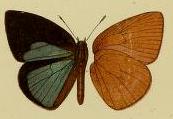
Stempfferia tumentia, the swollen epitola, is a butterfly in the family Lycaenidae. The species was first described by Hamilton Herbert Druce in 1910. It is found in Nigeria, Cameroon, the Republic of the Congo, the Central African Republic and the Democratic Republic of the Congo. The habitat consists of forests.
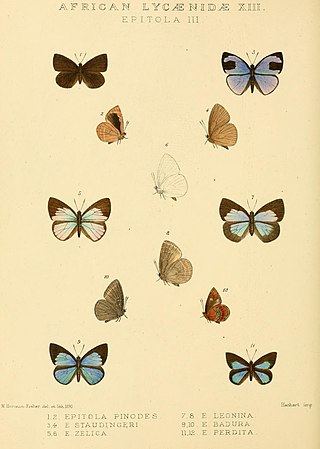
Cephetola pinodes, or Druce's epitola, is a butterfly in the family Lycaenidae. The species was first described by Hamilton Herbert Druce in 1890. It is found in Sierra Leone, Ivory Coast, Ghana, Nigeria, Cameroon, the Republic of the Congo, the Central African Republic, the Democratic Republic of the Congo, Uganda and Tanzania.
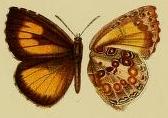
Lachnocnema luna, or Druce's large woolly legs, is a butterfly in the family Lycaenidae. The species was first described by Hamilton Herbert Druce in 1910. It is found in Ghana, eastern Nigeria, Cameroon, Gabon, the Republic of the Congo, the north-eastern part of the Democratic Republic of the Congo, Uganda and north-western Tanzania. The habitat consists of forests.
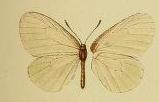
Ornipholidotos paradoxa is a butterfly in the family Lycaenidae first described by Hamilton Herbert Druce in 1910. It is found in Cameroon, the Republic of the Congo, the Central African Republic, the Democratic Republic of the Congo, Uganda and Tanzania.

Mimeresia russulus is a butterfly in the family Lycaenidae first described by Hamilton Herbert Druce in 1910. It is found in Cameroon, the Republic of the Congo, the Democratic Republic of the Congo and Uganda. It is a forest butterfly but little is known about its life cycle with no published information on the larval stages or larval food.









